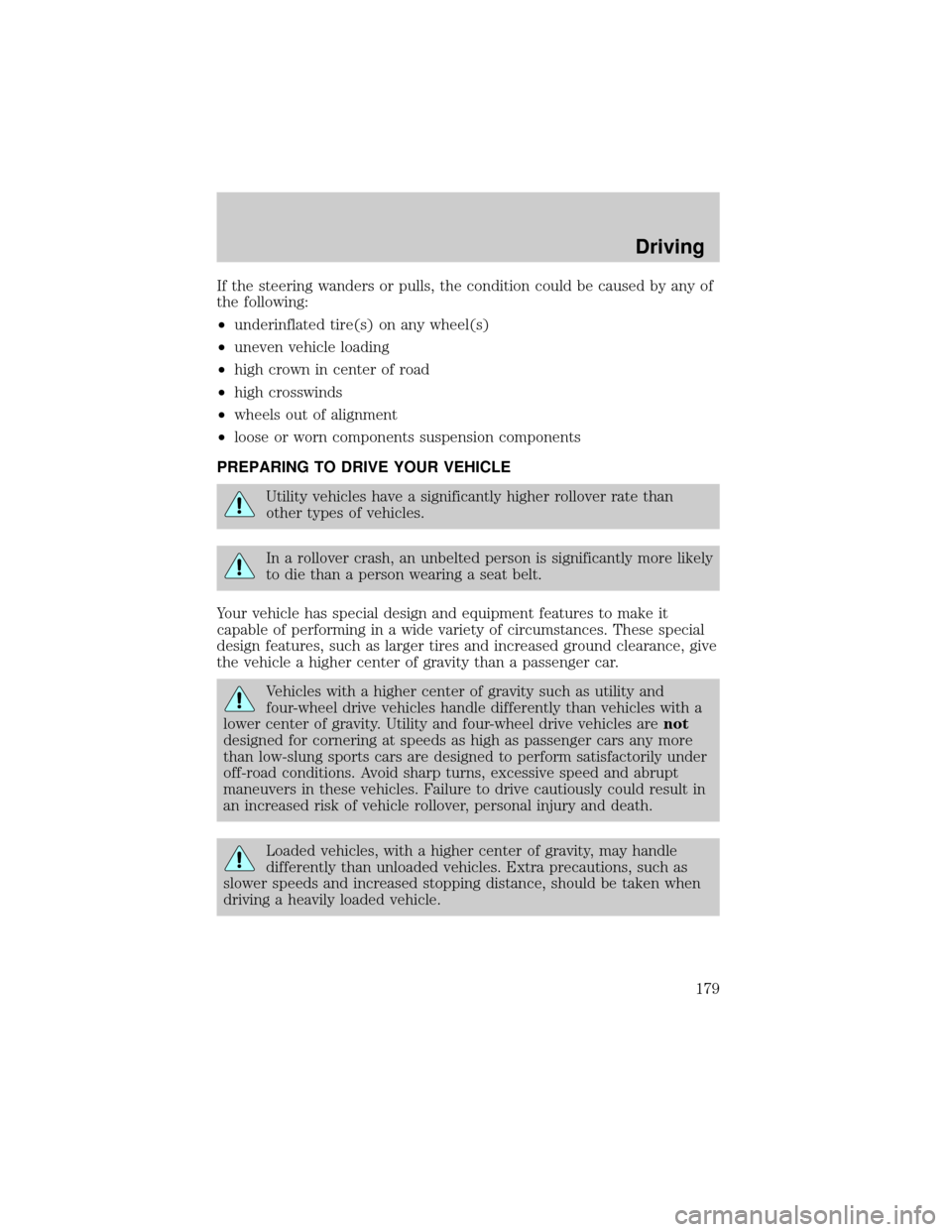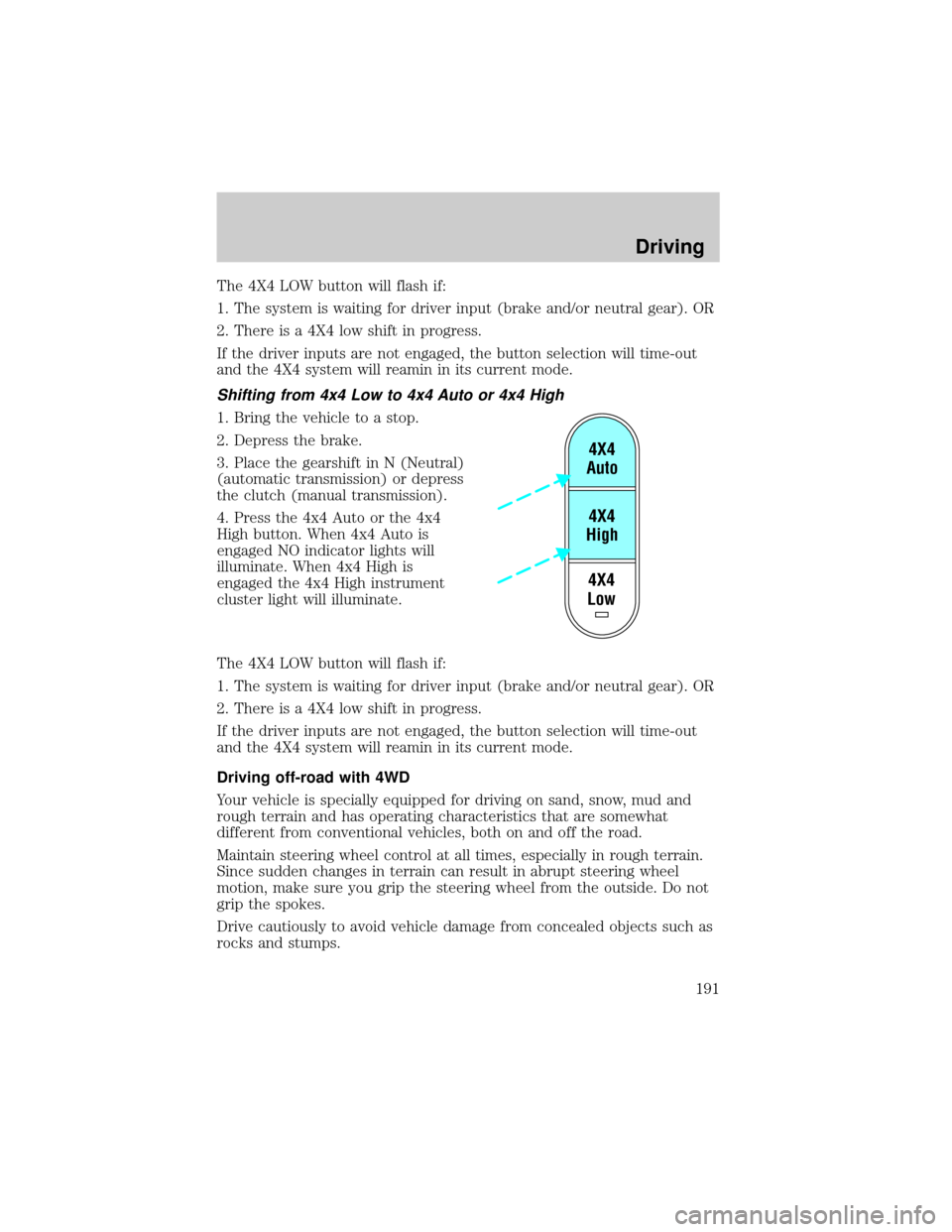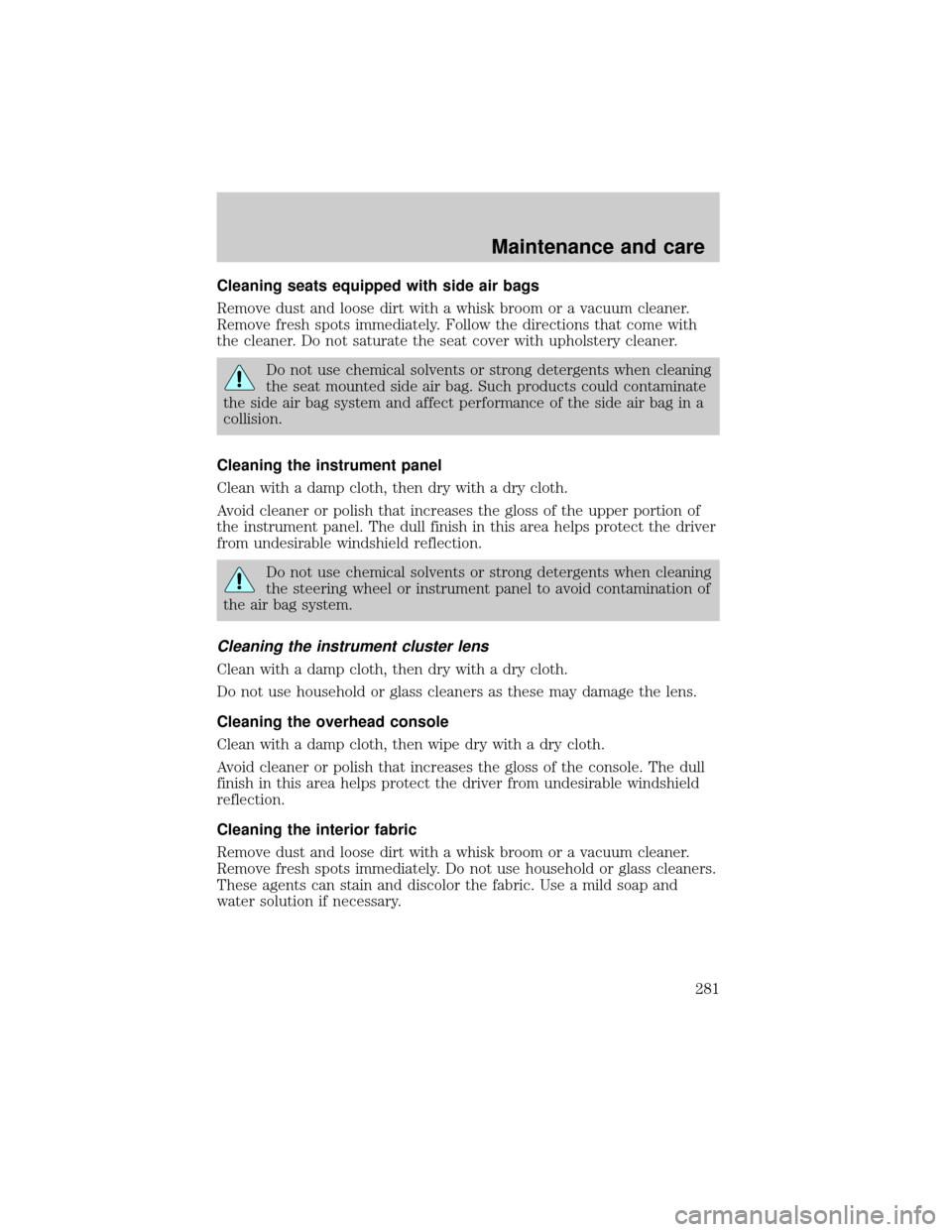2002 FORD EXPLORER steering wheel
[x] Cancel search: steering wheelPage 179 of 312

If the steering wanders or pulls, the condition could be caused by any of
the following:
²underinflated tire(s) on any wheel(s)
²uneven vehicle loading
²high crown in center of road
²high crosswinds
²wheels out of alignment
²loose or worn components suspension components
PREPARING TO DRIVE YOUR VEHICLE
Utility vehicles have a significantly higher rollover rate than
other types of vehicles.
In a rollover crash, an unbelted person is significantly more likely
to die than a person wearing a seat belt.
Your vehicle has special design and equipment features to make it
capable of performing in a wide variety of circumstances. These special
design features, such as larger tires and increased ground clearance, give
the vehicle a higher center of gravity than a passenger car.
Vehicles with a higher center of gravity such as utility and
four-wheel drive vehicles handle differently than vehicles with a
lower center of gravity. Utility and four-wheel drive vehicles arenot
designed for cornering at speeds as high as passenger cars any more
than low-slung sports cars are designed to perform satisfactorily under
off-road conditions. Avoid sharp turns, excessive speed and abrupt
maneuvers in these vehicles. Failure to drive cautiously could result in
an increased risk of vehicle rollover, personal injury and death.
Loaded vehicles, with a higher center of gravity, may handle
differently than unloaded vehicles. Extra precautions, such as
slower speeds and increased stopping distance, should be taken when
driving a heavily loaded vehicle.
Driving
179
Page 191 of 312

The 4X4 LOW button will flash if:
1. The system is waiting for driver input (brake and/or neutral gear). OR
2. There is a 4X4 low shift in progress.
If the driver inputs are not engaged, the button selection will time-out
and the 4X4 system will reamin in its current mode.
Shifting from 4x4 Low to 4x4 Auto or 4x4 High
1. Bring the vehicle to a stop.
2. Depress the brake.
3. Place the gearshift in N (Neutral)
(automatic transmission) or depress
the clutch (manual transmission).
4. Press the 4x4 Auto or the 4x4
High button. When 4x4 Auto is
engaged NO indicator lights will
illuminate. When 4x4 High is
engaged the 4x4 High instrument
cluster light will illuminate.
The 4X4 LOW button will flash if:
1. The system is waiting for driver input (brake and/or neutral gear). OR
2. There is a 4X4 low shift in progress.
If the driver inputs are not engaged, the button selection will time-out
and the 4X4 system will reamin in its current mode.
Driving off-road with 4WD
Your vehicle is specially equipped for driving on sand, snow, mud and
rough terrain and has operating characteristics that are somewhat
different from conventional vehicles, both on and off the road.
Maintain steering wheel control at all times, especially in rough terrain.
Since sudden changes in terrain can result in abrupt steering wheel
motion, make sure you grip the steering wheel from the outside. Do not
grip the spokes.
Drive cautiously to avoid vehicle damage from concealed objects such as
rocks and stumps.
4X4
Low4X4
High4X4
Auto
Driving
191
Page 217 of 312

Auxiliary relay box (trailer tow)
The relay box is located on the front right fender well underneath the
speed control module.
The relays are coded as follows:
Fuse/Relay Location Description
Relay 64 Trailer Tow (left turn)
Relay 65 Trailer Tow (right turn)
Relay 66 Not Used
CHANGING THE TIRES
If you get a flat tire while driving, do not apply the brake heavily.
Instead, gradually decrease your speed. Hold the steering wheel firmly
and slowly move to a safe place on the side of the road.
Spare tire information
The spare tire can be used as a spare or a regular tire. The spare is
identical to the other tires on your vehicle, although the wheel will not
match.
If your vehicle is equipped with 4WD or AWD, a spare tire of a
different size than the road tires should not be used. Such a tire
could result in damage to driveline components and make the
vehicle difficult to control.
Roadside emergencies
217
Page 248 of 312

²4.0L SOHC V6 engine
²4.6L V8 engine
1. Start the engine and let it run until it reaches normal operating
temperature (the engine coolant temperature gauge indicator will be
near the center of the normal area between H and C).
2. While the engine idles, turn the steering wheel left and right several
times.
3. Turn the engine off.
4. Check the fluid level in the reservoir.
5. The fluid level should be between the MIN and MAX lines. Do not add
fluid if the level is in this range.
6. If the fluid is low, add fluid in small amounts, continuously checking
the level until it reaches the correct operating range. Be sure to put the
cap back on the reservoir.
TRANSMISSION FLUID
Checking automatic transmission fluid (if equipped)
The 5R55W transmission does not have a transmission fluid dipstick.
Maintenance and care
248
Page 281 of 312

Cleaning seats equipped with side air bags
Remove dust and loose dirt with a whisk broom or a vacuum cleaner.
Remove fresh spots immediately. Follow the directions that come with
the cleaner. Do not saturate the seat cover with upholstery cleaner.
Do not use chemical solvents or strong detergents when cleaning
the seat mounted side air bag. Such products could contaminate
the side air bag system and affect performance of the side air bag in a
collision.
Cleaning the instrument panel
Clean with a damp cloth, then dry with a dry cloth.
Avoid cleaner or polish that increases the gloss of the upper portion of
the instrument panel. The dull finish in this area helps protect the driver
from undesirable windshield reflection.
Do not use chemical solvents or strong detergents when cleaning
the steering wheel or instrument panel to avoid contamination of
the air bag system.
Cleaning the instrument cluster lens
Clean with a damp cloth, then dry with a dry cloth.
Do not use household or glass cleaners as these may damage the lens.
Cleaning the overhead console
Clean with a damp cloth, then wipe dry with a dry cloth.
Avoid cleaner or polish that increases the gloss of the console. The dull
finish in this area helps protect the driver from undesirable windshield
reflection.
Cleaning the interior fabric
Remove dust and loose dirt with a whisk broom or a vacuum cleaner.
Remove fresh spots immediately. Do not use household or glass cleaners.
These agents can stain and discolor the fabric. Use a mild soap and
water solution if necessary.
Maintenance and care
281
Page 305 of 312

Child safety seats ......................163
attaching with tether straps ..167
in front seat ............................165
in rear seat ..............................165
Cleaning your vehicle ...............277
engine compartment ..............278
exterior ....................................278
exterior lamps .........................280
instrument cluster lens ..........281
instrument panel ....................281
interior .....................................281
mirrors .....................................282
plastic parts ............................280
safety belts ..............................282
washing ....................................277
waxing .....................................278
wheels ......................................280
windows ..................................282
wiper blades ............................280
woodtone trim ........................282
Climate control (see Air
conditioning or Heating) ............33
Clock ..........................56, 62, 72, 86
Clutch
operation while driving ..........185
recommended shift speeds ....186
Compass, electronic ....................17
calibration .................................19
set zone adjustment ...........18, 20
Console ......................................112
overhead ..................................100
rear ..........................................113
Controls
power seat ...............................133
steering column ........................99
Coolant
checking and adding ..............241
refill capacities ................245, 283
specifications ..................285, 287Cruise control
(see Speed control) ....................90
Customer Assistance ................205
Ford accessories
for your vehicle ......................298
Ford Extended
Service Plan ............................291
Getting assistance outside
the U.S. and Canada ..............297
Getting roadside assistance ...205
Getting the
service you need ....................291
Ordering additional
owner's literature ...................302
The Dispute
Settlement Board ...................294
Utilizing the Mediation/
Arbitration Program ...............297
D
Daytime running lamps
(see Lamps) ................................28
Defrost
rear window ..............................50
Dipstick
automatic
transmission fluid ...................248
engine oil .................................235
Doors
door ajar warning .....................12
lubricant specifications ..........285
Driveline universal joint
and slip yoke .............................251
Driving under special
conditions ..................................193
mud ..........................................192
sand .........................................192
snow and ice ...................192±193
Index
305
Page 309 of 312

fluid, checking and adding ....247
fluid, refill capacity ................283
fluid, specifications .........285, 287
Preparing to
drive your vehicle .....................179
R
Radio ............................................51
Relays ................................207, 216
Remote entry system .......115, 117
illuminated entry ....................120
locking/unlocking doors .........116
opening the trunk ...................117
panic alarm .............................117
replacement/additional
transmitters .............................119
replacing the batteries ...........118
Reverse sensing system .............30
Roof rack ...................................204
S
Safety belts (see Safety
restraints) ............13, 142±146, 149
Safety defects, reporting ..........303
Safety restraints ........142±146, 149
belt minder .............................151
cleaning the
safety belts ......................154, 282
extension assembly ................150
for adults .........................143±146
for children .............................162
lap belt ....................................147
warning light
and chime ....................10, 13, 150
Safety seats for children ..........163Seat belts
(see Safety restraints) .............142
Seats ..........................................131
child safety seats ....................163
cleaning ...........................281±282
memory seat ...................117, 134
SecuriLock passive
anti-theft system .......127±128, 130
Servicing your vehicle ..............229
Snowplowing .................................3
Spark plugs,
specifications .....................283, 287
Special notice ................................3
ambulance conversions ..............3
utility-type vehicles ....................3
Specification chart,
lubricants ...........................285, 287
Speed control ..............................90
Speedometer ...............................14
Starting your
vehicle ........................171, 173±174
jump starting ..........................222
Steering wheel
controls ......................................99
tilting .........................................96
T
Tachometer .................................16
Tires ...........................217, 254±256
changing ..........................217, 219
checking the pressure ............256
replacing ..................218±219, 257
rotating ....................................256
snow tires and chains ............258
tire grades ...............................255
treadwear ................................255
Index
309